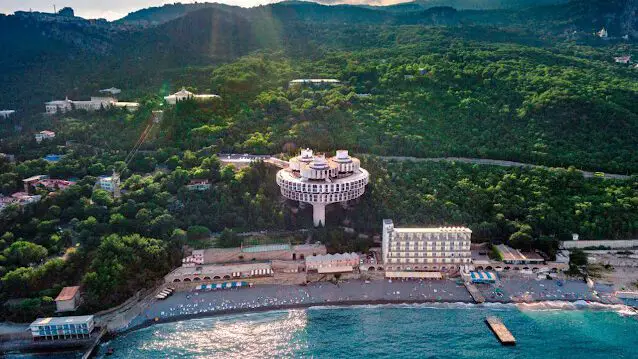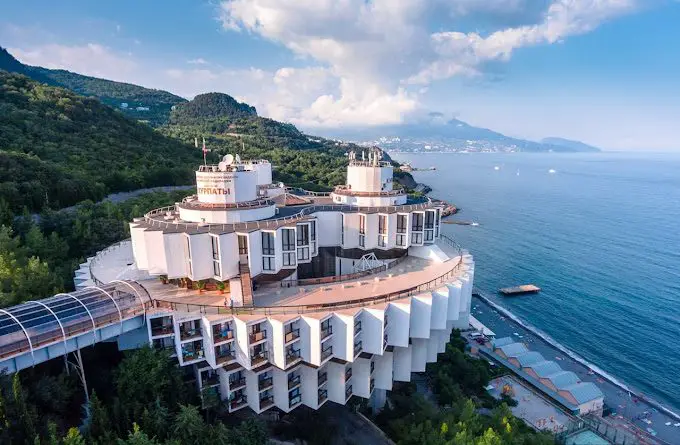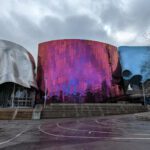The Iconic Druzhba Holiday Center, Yalta, Ukraine: A Walk Through Architectural Brilliance
In Soviet architecture, where form often rigidly followed function, the Druzhba Sanitorium emerged as a striking anomaly. Constructed as a joint Czech and USSR project, its completion in 1985 marked the creation of a health resort and the realization of an architectural utopia. Designed by Igor Vasilevsky, this modernist masterpiece challenges the laws of gravity on a seismic fault line perched on a hillside overlooking the Black Sea. As we delve into the history and design of Druzhba, we uncover a story that goes beyond mere concrete and steel, a narrative of aspiration, reward, and a touch of intergalactic allure.

A Symbol of Collaboration
“Druzhba” translates to “friendship,” symbolizing the collaboration between Czechoslovakia and the USSR. This joint venture, initiated in 1978 and completed in 1985, was conceived as a health retreat, offering a unique blend of therapeutic amenities and architectural innovation. However, the choice of the name raises an eyebrow, considering the political backdrop, including the 1968 Operation Danube when Warsaw Pact tanks entered Czechoslovakia, stifling the Prague Spring.
Soviet Sanitoria: A Different Perspective
To comprehend the Soviet concept of a sanatorium, one must shed preconceived notions. Unlike the idyllic image associated with sanatoria, Soviet citizens considered visiting a sanatorium a reward—a break from the ordinary. State-subsidized and often distributed through factory committees or trade unions, these retreats had tiers of access, reflecting the hierarchical structure of Soviet society.
Druzhba’s Unique Design Challenges
Soviet sanitoria were not just health havens but experimental grounds for architects. Druzhba, however, faced extraordinary challenges. The site, perched on a seismic fault, compelled architects to reimagine the conventional. Igor Vasilevsky, working with engineer Nodar Kancheli, devised a radical solution, constructing a building akin to a “stool on three legs.” The result was a structure seemingly defying gravity, perched on the hillside with unparalleled panoramic views of the Black Sea.
Architectural Experimentation
Konstantin Antipin, a photographer and writer who has explored Druzhba extensively, notes that Soviet sanitoria were meant to be “heaven on earth.” Despite the era’s struggles, no expense was spared in creating rest homes for deserving workers. Druzhba exemplifies this ethos through its bold design, serving as a testament to the Soviet commitment to providing an idyllic escape for its citizens.

Druzhba’s Design Legacy
The uniqueness of Druzhba lies in its defiance of gravitational norms and its contribution to Soviet architectural experimentation. The building’s aerial shots, captured by Antipin using drones, offer a view of the structure from perspectives often inaccessible due to high fences around heritage projects. As a cultural heritage site, Druzhba is now protected, ensuring its preservation for future generations.
Inside Druzhba: A Glimpse into the Past
Druzhba’s interior, captured through Antipin’s lens, unveils a mid-century interpretation of space-age innovation. The sizeable geometric doughnut shape and its facilities, including dance halls, a café, a cinema, a concert venue, a pool, and even a billiards room, evoke a sense of intergalactic space city. The restaurant, accessed via the roof with a 56-meter drop, adds a touch of theatricality reminiscent of a James Bond set.
Foreign Intrigue and Unintended Perceptions
Druzhba’s unique design did not escape the attention of foreign governments, some of whom speculated that the project concealed a rocket launch site. The unintended perception of an otherworldly endeavor adds a layer of intrigue to the sanatorium’s history.
Druzhba Sanitorium is a evidence to the audacious spirit of Soviet architectural experimentation. Its soaring design, perched on a seismic fault, challenges gravity and conventional norms. Beyond its architectural significance, Druzhba embodies the Soviet ideal of providing a haven for the working class, a reward for their contributions. As it transitions into a new era, hosting paying guests and health tourists, Druzhba continues to tell a story beyond its concrete and steel structure, a narrative of aspiration, reward, and the enduring allure of architectural utopia.
Further Information On The Druzhba Holiday Center
Date Construction Started: 1978
Date Opened: 1986
Cost Of Building: Modernism
Architect: Igor Vasilevsky
Architectural Style: Modernism
Size Or Floor Area: 27,000 square meters
Height: 16 meters
Function Or Purpose: Hotel
Address: N/A
Phone Number: N/A
Website: N/A
Opening Hours: N/A




